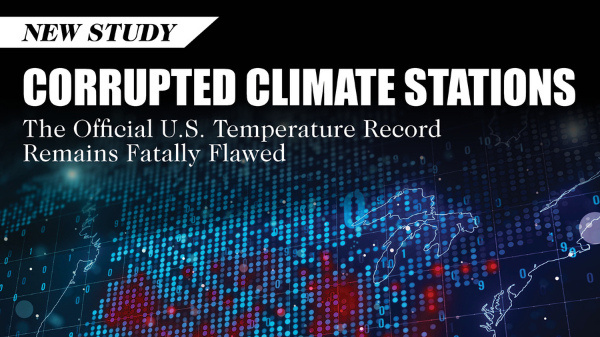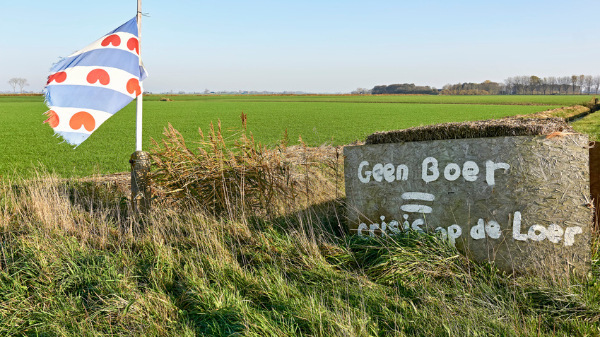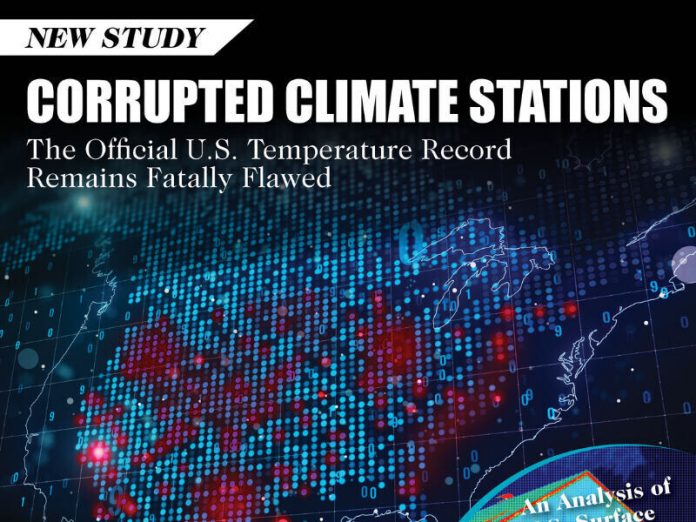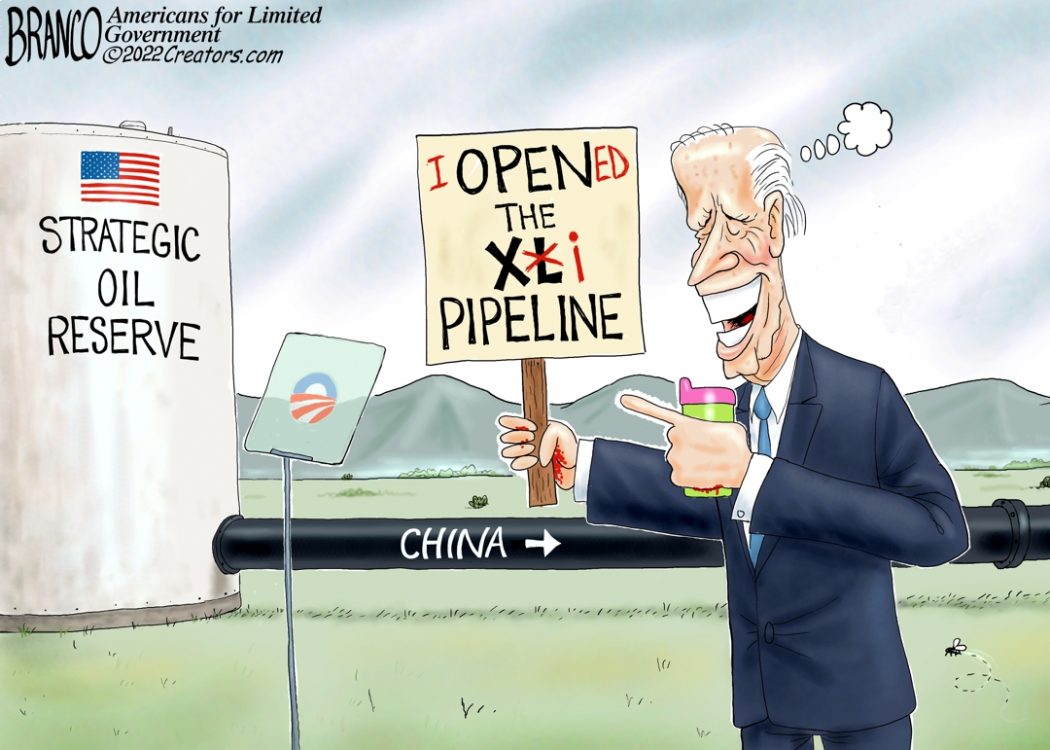YOU SHOULD SUBSCRIBE TO CLIMATE CHANGE WEEKLY.
IN THIS ISSUE:
- U.S. Surface Station Network Is Fatally Flawed, Heartland Report Shows
- Podcast of the Week: The Official U.S. Surface Temperature Record Remains Fatally Flawed (Guest: Anthony Watts)
- Dutch Farmers’ Climate Policy Protest Spreading
- Electric-Powered Police Cars Leaving Emergencies Untended
- Video of the Week: Why Are the Climate Change Solutions So Terrible?
- BONUS Video of the Week: Biden Unveils Insane Climate Plan, Remembering Dr. Patrick Michaels
- Climate Comedy
- Recommended Sites
U.S. Surface Station Network Is Fatally Flawed, Heartland Report Shows

Way back when climate change was still called global warming, the whole thing was a bit more honest. The basic underlying cause of how catastrophic climate change is supposed to be occurring is greenhouse gases accumulating in the atmosphere, trapping heat, warming the Earth, and driving myriad other changes such as worsening weather events.
The problem for that narrative is that the Earth has not been warming to the degree (pun fully intended) that climate models have consistently projected over the years it would. No catastrophic warming, no catastrophic climate change. If climate models are wrong about the most basic projection they were created to make, there is no reason to take any of their other projections seriously.
Worse news for climate alarmists—though not for normal people with other things to worry about—is that even the warming that has been recorded is a result of bias, not reality, with reported average temperatures being higher and trending steeper than if the system used accurate measurements. Proof of this has been published in a new report by The Heartland Institute: Corrupted Climate Stations: The Official U.S. Surface Temperature Record Remains Fatally Flawed. This report is an update of a 2009 study by meteorologist Anthony Watts, a Heartland senior fellow: Is The U.S. Surface Temperature Record Reliable? Spoiler alert: it wasn’t then, and it isn’t now.
The 2009 study found approximately 89 percent of the stations used by the National Oceanic and Atmospheric Administration (NOAA) to calculate average U.S. temperatures failed to meet the National Weather Service’s (NWS) siting standards, which stipulate stations must be 30 meters (100 feet) or more away from any artificial or radiating reflecting heat source. That was disgracefully poor performance. The new, updated report says the situation is now worse.
The 2009 report received widespread media attention, which sparked multiple agency audits and Inspector General investigations. Several scientific studies confirmed Watts’ results, all the while trying to downplay their importance. As one Inspector General report stated, “NOAA acknowledges that there are problems with the [United States Historical Climatology Network] data due to biases introduced by such means as undocumented site relocation, poor siting, or instrument changes.”
NOAA and the NWS took a variety of actions in the aftermath of the 2009 report, perhaps in response to it. Some were positive; others appear intended to bolster the claims of dangerously rising temperatures on which Watts’s study cast doubt.
On the positive side, the agencies closed some of the worst temperature stations, in particular those held out for specific ridicule in Watts’ 2009 report. These include stations in Marysville, California; at the University of Arizona; in Tucson; in Ardmore and Perry, Oklahoma; and in Lampasas, Texas. These stations were in or beside parking lots, highways, or buildings and/or adjacent to air conditioning units and barbecue pits. Unfortunately, as the new survey of stations found, other stations, although similarly badly located but not highlighted for specific attention in the initial report, remained open. Their biased temperature measurements are still distorting the official record.
NOAA also rolled out a new network of temperature stations: the U.S. Climate Reference Network (USCRN). Although the USCRN was in the works while Watts was compiling his data, the final rollout of 114 stations wasn’t completed until 2012. It comprises a subset of existing temperature gauge locations that meet all NWS conditions for unbiased, high-quality temperature data that are not expected to be affected by nearby development or the placement of artificial heat sources for at least the next 50 years. The National Climate Data Center described the USCRN thus:
The USCRN measures temperature with superior accuracy and continuity in places that land-use change will not likely impact during the next five decades. Built specifically for this purpose … [t]he USCRN serves, as its name and original intent imply, as a reference network for operational estimates of national-scale temperature.
Concurrent with the creation of the USCRN, NOAA developed a second new temperature recording and reporting network, adding thousands of stations from the Global Historical Climatology Network to NOAA’s Historical Climate Network of 1,218 stations for a new dataset it called “nClimGrid.” This new system collects data from more than 10,000 high-quality (unbiased) and low-quality (biased) stations alike.
Would it surprise any of CCW’s regular readers to learn that in its monthly and annual reports on temperature and weather trends, NOAA does not use or cite the data from the unbiased USCRN? Instead, the federal government’s official reports cite data from the woefully inadequate, fatally compromised nClimGrid network. Why would that be, one wonders, since NOAA acknowledges the USCRN has, in its own words, “superior accuracy”? Could it be because the USCRN dataset shows warming of less than half that recorded by the broader, biased system? The USCRN shows an unalarming amount of warming, which doesn’t make for compelling reports motivating large-scale government action and increased funding and personnel for the agencies.
For the new report, Watts and his team of volunteers surveyed a representative sample of the original temperature gauges and the more recent nClimGrid network, in different regions across the country. The results were worse than even I could have imagined. As the media advisory on the report states, “96% of U.S. Climate Data Is Corrupted.” You read that right. Instead of improving station siting and reporting since the 2009 report, the temperature dataset NOAA uses for official reports has gotten worse.
This survey confirms what independent studies have also found, as Watts noted in his statement: “The issue of localized heat-bias with these stations has been proven in a real-world experiment conducted by Oak Ridge National Laboratory and published in a peer reviewed science journal.”
I suggest you read Watts’s shocking report in full before the corporate media coverage biases everyone’s view of the study by twisting or downplaying the importance of its findings and critique. For me the main takeaway is threefold. First, the government is either inept or stubbornly refusing to learn from its mistakes for political reasons, with possibly both at play. Second, the government’s official temperature record can’t be trusted. It reflects a clear urban heat-bias effect, not national temperature trends. Third, you can’t trust the official temperature record, and with rising temperatures supposedly driving dangerous climate change, you shouldn’t trust the government’s projections of worsening extreme weather events.
It’s just not getting as hot as fast as climate alarmists within and outside the government are telling us.
SOURCE: The Heartland Institute
Podcast of the Week
The temperature data sets used in official government reports making alarming claims about rapidly rising temperatures and dangerous climate change come from a fatally flawed network of weather stations. More than 96 percent of the stations surveyed fail to meet the National Weather Service’s requirements for quality measurements.
As a result, the official temperature record is biased, being more than twice as hot as records from the U.S. Climate Reference Network. If we can’t trust the temperature records, which is supposed to be the driving force for dangerous climate change, why should we trust the predictions of worsening extreme weather made by government agencies?
Subscribe to the Environment & Climate News podcast on Apple Podcasts, iHeart, Spotify or wherever you get your podcasts. And be sure to leave a positive review!
Get your Copy at Amazon TODAY!
Dutch Farmers’ Climate Policy Protest Spreading

News outlets around the world have been reporting on the weeks-long protests by farmers in the Netherlands against the government’s climate policies, which it acknowledges may put 30 percent of the country’s farmers out of business. This is one of the worst possible times for the nation’s parliament to spring this proposal. Famine in parts of Africa, the ongoing war in Ukraine, and high energy prices and supply chain problems hampering fertilizer availability have sharply curtailed crop production and transport.
The Netherlands is the European Union’s (EU) second-largest exporter of agricultural products. To comply with EU climate diktats, the Dutch parliament proposes limiting the use of nitrogen fertilizer by as much as 95 percent in some regions of the country and removing a large portion of the nation’s cattle herds, to reduce emissions. The government admits these policies will put some farmers out of business.
“If successfully implemented, the state initiative to ‘go green’ would almost certainly cripple the country’s private agricultural industry, as the regulations are ‘expected to include reducing livestock and buying up some farms whose animals produce large amounts of ammonia,’” The Federalist reports. “‘The honest message … is that not all farmers can continue their business,’ the government admitted in a statement last month.”
In response, Dutch farmers began widespread protests, which have lasted more than three weeks now. Among the actions farmers have taken to protest the climate proposals are bringing hundreds of cows to Parliament and threatening to slaughter them; spraying manure on parliament buildings; protesting outside government ministers’ homes and dumping manure there; parking more than 40,000 tractors and work trucks on the nation’s highways, bringing traffic to a standstill; and most recently, as The Federalist reports, “dozens of farmers in trucks and tractors parked outside major supermarket distribution centers in cities throughout the country.”
In a show of solidarity with the farmers, Dutch commercial fishermen joined the protests and have begun using their ships to block ports throughout the country. This has resulted in ferries and other ships being delayed by hours.
The government’s initial response was to issue citations and fines to hundreds of farmers for blocking roads. Now the government has turned violent, with police in some cities firing tear gas and using dogs to break up protests. In at least one instance, police fired live rounds above and at farmers driving tractors.
Will this become a common occurrence across Europe as more EU countries impose increasingly draconian restrictions on their industries and people to comply with the climate demands of unelected EU bureaucrats? Who knows? This does remind me of the yellow vest protests in France, which began in 2018 only to die down with the onset of COVID restrictions in 2020. The protests were initially sparked by hikes in fuel taxes and new energy fees imposed to force people to drive less and buy new appliances for their homes in order to fight climate change. The protests eventually broadened to cover a wider range of policy issues. The protestors hampered transit and business for months.
Initially the government vowed to move forward with its policies. Ultimately, it bowed to the protestors’ demands and rescinded them—after a lot of unnecessary anguish and government violence.
SOURCES: Summit News; The Federalist; Bloomberg
Heartland’s Must-read Climate Sites
Electric-Powered Police Cars Leaving Emergencies Untended

As rural police departments in the United Kingdom replace vehicles powered by internal combustion engines with electric police cars, “officers [are] struggling to reach crime scenes when they ‘run out of puff,’ according to one police chief,” The Daily Mail reports.
Gloucestershire’s police force has the largest percentage of electric vehicles in its fleet. This has become a problem, Gloucestershire Police and Crime Commissioner Chris Nelson told The Daily Mail. On multiple occasions, police officers have been unable to reach emergencies in a timely fashion because their vehicles ran out of power, Nelson said.
When asked at a public hearing by County Councillor Steve Robinson whether electric vehicles should compose a larger part of the fleet, Nelson responded, “We’ve all got to go towards electric vehicles moving forwards.”
“The design options available for electric vehicles for operational uses are not perhaps as advanced as I would like them to be,” Nelson admitted. “So, let’s put it like this: I’m cautious about going any further down that road at this stage.”
Nelson put the blame not on the inherent limits of the vehicles but on a scarcity of rural charging stations. The author of the Daily Mail article had a harsher assessment, writing,
To point the finger at a lack of charging points misses the point: are his officers expected to spend an hour charging up, even when they have found one, while an emergency is going on down the road?
Given the size of the police cars we are typically talking about, limited range will be an issue on most days. Batteries will need recharging after just two or three hours of driving, which I would guess would be a typical day for rural police.
SOURCE: The Daily Mail
Video of the Week:
Why Are the Climate Change Solutions So Terrible?
The Heartland Institute’s Donald Kendal, Jim Lakely, and Chris Talgo present episode 356 of the In The Tank Podcast. The latest bout of climate hysteria has highlighted a lot of absurdity in regards to the proposed solutions. From the shortcomings of wind and solar energy to the disastrous outcomes of new farming regulations, the environmental left seems more detached from reality than ever. Also, a new report from the World Economic Forum seems to back up the globalist claim that “in the future, you will own nothing.”
BONUS Video of the Week: Biden Unveils Insane Climate Plan, Remembering Dr. Patrick Michaels
Democrats failed to pass sweeping legislation remaking America under the guise of a climate emergency. Thus, they turned to Joe Biden to enact a swath of executive orders to force their desires on all Americans. Biden did not declare a climate emergency, but did vow to do everything he can using executive orders and the power of the executive branch to advance his alarmist agenda.
But more importantly, climate science lost a true warrior this week, Dr. Patrick Michaels. Dr. Michaels was a trailblazer in objective climate science and source of inspiration for researchers in pursuit of the truth.






 via
via 























Well, I looked at the USCRN website earlier this week and I could not find a temperature plot anywhere. I just figured I had missed it. At this stage, I tend to agree that with the updated, more accurate temperature data obtained from the 142 stations in the network NOAA would be EAGER to share that data plot if you had an HONEST scientific approach. My suspicion (as well) is the trend line doesn’t fit the narrative.
[…] was illustrated in H. Sterling Burnett’s recent Climate Change Weekly #442 for the Heartland Institute, reporting on the work of Anthony Watts, which showed the “U.S. […]
[…] was illustrated in H. Sterling Burnett’s recent Climate Change Weekly #442 for the Heartland Institute, reporting on the work of Anthony Watts, which showed the “U.S. […]
[…] was illustrated in H. Sterling Burnett’s recent Climate Change Weekly #442 for the Heartland Institute, reporting on the work of Anthony Watts, which showed the “U.S. […]
[…] was illustrated in H. Sterling Burnett’s recent Climate Change Weekly #442 for the Heartland Institute, reporting on the work of Anthony Watts, which showed the “U.S. […]
[…] was illustrated in H. Sterling Burnett’s recent Climate Change Weekly #442 for the Heartland Institute, reporting on the work of Anthony Watts, which showed the “U.S. […]
[…] was illustrated in H. Sterling Burnett’s recent Climate Change Weekly #442 for the Heartland Institute, reporting on the work of Anthony Watts, which showed the “U.S. […]
[…] was illustrated in H. Sterling Burnett’s recent Climate Change Weekly #442 for the Heartland Institute, reporting on the work of Anthony Watts, which showed the “U.S. […]
[…] was illustrated in H. Sterling Burnett’s current Climate Change Weekly #442 for the Heartland Institute, reporting on the work of Anthony Watts, which confirmed the “U.S. […]
[…] was once illustrated in H. Sterling Burnett’s fresh Local weather Alternate Weekly #442 for the Heartland Institute, reporting at the paintings of Anthony Watts, which confirmed the […]